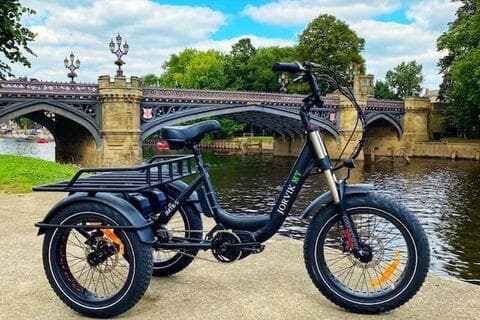So you’re thinking about giving a tricycle a try, huh? Great idea! Tricycles can be a fun mode of transportation, offering more stability and comfort than traditional bicycles.
But you might be asking yourself, “Can I ride a tricycle on the road?” Well, you’ve come to the right place for answers.
In general, tricycles are allowed on public roads just like bicycles. Keep in mind that as a tricycle rider, you have the same rights and responsibilities as other vehicles on the road. This means you should travel with the flow of traffic, obey traffic laws, and use caution when navigating through intersections, turns, or other potentially tricky situations.
It’s crucial to consider your safety and the safety of others around you.
Now that we’ve established that tricycles can be ridden on the road, it’s essential to know some basic tips for a smooth ride:
- For starters, always wear a helmet, be visible with proper lights and reflectors, and stay aware of your surroundings.
- Riding an adult tricycle might feel a bit different than riding a bike, so give yourself some time to get used to it.
Can You Ride A Tricycle On The Road?
So, you’re wondering if you can ride a tricycle on the road, right? Well, you’re in the right place, my friend! Let’s dive into this interesting topic together.
First things first, tricycles are actually pretty easy to ride compared to bikes, making them an excellent choice for many riders, especially those who may have balance issues. Plus, you can’t deny that they look pretty cool too, right?
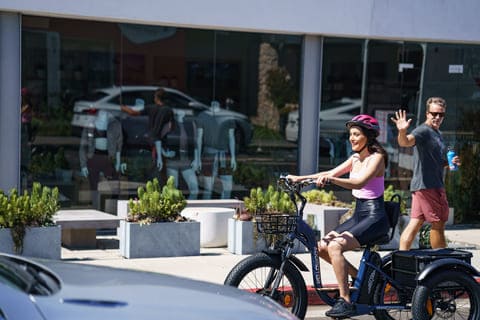
Livestrong offers some quick tips on riding a tricycle if you’re new to it.
Now, onto the big question – can you ride a tricycle on the road? Absolutely! However, just like when riding a bike, there are some rules and legal aspects you should be aware of before hitting the road.
For instance, did you know that it’s actually legal for cyclists to ride two abreast on the road? That means you and your buddy can ride side by side on your tricycles!
Just be careful not to ride more than two abreast, and avoid doing so on narrow roads and around bends, as noted on Total Women’s Cycling.
As you cruise down the road with your awesome tricycle, make sure to follow these crucial safety tips:
- Ride more slowly on unfamiliar roads.
- Keep your eyes peeled for potential hazards.
- Ride with the road camber, since many roads are slightly tilted for water runoff (RyDoze).
- Obey local and state-specific rules and regulations, which you can often find on websites like TxDOT.
Now that you’re armed with this knowledge, go on and enjoy your tricycle rides on the road! Remember to always stay safe, be aware of your surroundings, and most importantly, have fun. After all, isn’t that what riding a tricycle is all about?
Can You Ride A Tricycle On The Pavement?
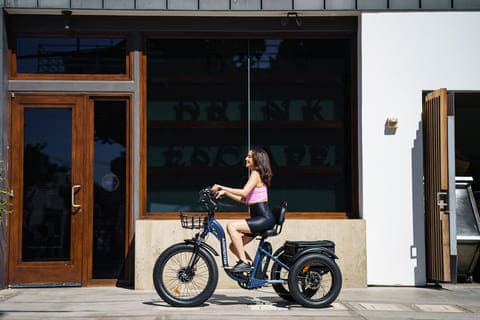
Laws for riding a tricycle on the pavement vary by location. In many places, tricycles follow the same rules as bicycles. Some areas permit riding on pavements, especially on designated shared paths. It’s crucial to check local laws before riding a tricycle on the pavement.
Road Rules And Safety
Rules Of The Road
So, you want to ride your tricycle on the road? Just like with bicycles, you have the same rights and responsibilities as motorists when riding a tricycle on the road.
This means you need to obey traffic signals, stop signs, and ride with the flow of traffic by using the rightmost lane headed in the direction you’re going 1 2.
Cycling Etiquette
Riding a tricycle on the road means sharing the road with others. You want to ensure that everyone gets along and stays safe, right? This includes:
- Yielding to pedestrians: Give them the right of way, and always be on the lookout for folks crossing the road.
- Making eye contact: Communicate with other road users by making eye contact to establish your intentions.
- Using hand signals: Signal your intentions to turn, stop, or change lanes to keep everyone informed.
- Passing on the left: Always pass other road users on their left side, and give them plenty of space.
Safety Tips And Precautions
Now that we’ve covered the rules and etiquette, let’s talk about staying safe on your tricycle! Here are some helpful tips:
- Be visible: Wearing bright colors and using lights and reflectors can help others see you, especially in low-light conditions 2.
- Watch out for road hazards: Keep an eye out for potholes or debris that could cause a problem, and safely maneuver around them.
- Slow down when turning: Tricycles require all three wheels to maintain contact with the ground for balance. Keep your weight low and centered over the tricycle, and slow down when taking sharp or banked turns 3.
Safety Gear
Investing in some essential safety gear can also help keep you safe on the road:
- Helmet: A properly fitted helmet can protect your head in case of an accident or fall.
- Gloves: Cycling gloves offer a better grip and can help protect your hands from injury.
- Reflective clothing: Increase your visibility to drivers by wearing reflective clothing or accessories.
Follow these guidelines as you take your tricycle out for a spin and enjoy the freedom of the open road while staying safe and respectful of other road users.
Navigating Terrain On A Tricycle

Sidewalks And Pedestrian Areas
Tricycles are versatile vehicles that can be ridden on various surfaces. When riding on sidewalks and pedestrian areas, make sure you’re aware of your surroundings. Watch out for pedestrians, especially children, and give them enough space.
As you’re cycling, use your handlebars to steer and maintain control of your tricycle. Remember, you’re sharing the space with others, so it’s essential to be courteous and respectful.
Street And Driveway Cycling
Tricycles can also be ridden on streets and in driveways. However, it’s crucial to ride with caution and be aware of other vehicles on the road.
When cycling on the street, be mindful of your tricycle’s width and make sure you’re visible to cars and other cyclists. Use your handlebars to steer and brake effectively. If you’re riding on a driveway, watch out for obstacles or uneven surfaces in your wheel paths that might cause you to lose control.
Navigating Intersections And Alleyways
Riding a tricycle at intersections and alleyways can be a bit more challenging, but with proper techniques, you can do it safely.
When approaching an intersection, be sure to signal your intentions using hand signals and make eye contact with drivers or other cyclists, so they’re aware of your movements.
As you navigate through the intersection, use your handlebars to steer and control the tricycle’s speed. When riding through alleyways or narrow spaces, maintain a steady speed and avoid making sudden turns or abrupt stops.
Remember, riding a tricycle on the road requires awareness and caution.
When navigating various terrains and areas, be mindful of your surroundings, cycle at a safe speed, and adapt your riding strategies to the situation. Following these tips will help ensure a safe and enjoyable tricycle riding experience.
Considerations For Riding An Adult Tricycle On The Road
So, you’re thinking about riding an adult tricycle on the road, huh? Before hopping on and hitting the streets, let’s go over some factors to consider.

- Safety First: Riding an adult tricycle on the road can be a bit different from riding a traditional bicycle. With its three wheels, a tricycle offers more stability but also requires you to be more mindful of road conditions. Have you ever noticed how many roads are cambered, or tilted, to help with water runoff? While this may not affect a bicycle much, it can be more noticeable on a tricycle, so be prepared to lean into those tilts Rydoze.
- Traffic Factors: We all know that sharing the road with cars can be a bit intimidating. When riding your adult tricycle, make sure you stay visible to drivers and signal your turns. Remember that tricycles can have a wider turning radius than bicycles, so be cautious when making turns, especially in heavy traffic.
- The Law: Are you aware of your local laws regarding tricycles on the road? While they may vary from place to place, most jurisdictions consider adult tricycles to be similar to bicycles and follow the same rules of the road. It’s always a good idea to double-check your local regulations before heading out for a spin.
- Adjusting Pace: Keep in mind that tricycles are generally slower than bicycles, so be prepared to adjust your pace accordingly. That leisurely cruise around the block might take a bit longer, so give yourself extra time when planning your route.
- Getting Used to It: Just like riding any new type of vehicle, getting used to riding an adult tricycle takes practice. Before hitting the road, practice steering, braking, and maneuvering in a safe area like a parking lot or quiet street. This way, when you’re ready to conquer the open road, you’ll feel more confident with your newfound trike skills.
Considerations For Riding A Recumbent Trike On The Road
First things first, recumbent trikes can be a little tricky to maneuver, especially in off-road situations or tight spaces.
Unlike regular bikes, you can’t shift your weight to change direction as easily 1. So, it’s essential to practice handling your recumbent trike in various situations before hitting the road.
Now, let’s talk about speed. Riding a recumbent trike can feel different at higher speeds. It is important to learn the dynamics of your trike at slower speeds before picking up pace 2.
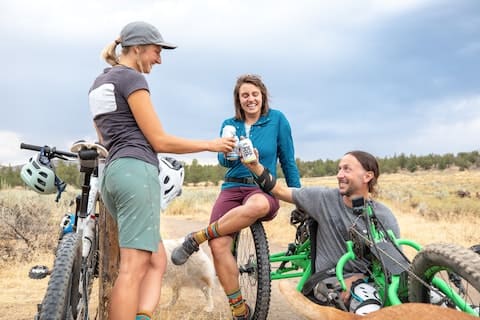
Try riding on quiet streets or parking lots to get the hang of it. And don’t forget, always lean into turns to avoid lifting a wheel or losing control 2.
One potential drawback you might face? “Recumbutt,” or butt numbness while riding a recumbent. Some riders experience this issue 4, but no worries – you’ll likely get more comfortable in your riding position over time.
Lastly, consider gearing when conquering steep climbs on your recumbent trike.
Thanks to the trike’s stability at slow speeds, you can tackle steep hills by making the right gearing choices ahead of time 5.
Gear down and maintain a high cadence for a smooth climb. Remember, practice makes perfect, and you’ll soon find yourself confident and capable on your recumbent trike.
Avoiding And Recovering From Falls
Preventing Falls
Riding a tricycle on the road can be a fun and convenient mode of transportation.
However, it’s essential to minimize the risk of falling, especially when you’re sharing the road with cars and other vehicles. So, how can you avoid falling over and stay safe on your trike? Don’t worry, I’ve got you covered.
First and foremost, maintain a lower center of gravity. Since tricycles have a wider wheelbase than bicycles, they provide greater stability.
However, you still need to be cautious when making turns and maneuvering around obstacles. By keeping your weight low and centered, you’ll reduce the risk of tipping over.
As for riding in a group, it’s best to ride a single file when sharing the road with cars.
Not only does this make it easier for vehicles to pass you safely, but it also minimizes the risk of collisions between riders.
Be sure to keep a safe distance from other trikes and communicate any changes in direction or potential hazards.
Recovering From Falls
Unfortunately, falls can still happen even when taking precautions. That’s okay. The key is knowing how to recover from them safely and efficiently. So, what do you do if you find yourself on the ground after a spill? Let’s go over some steps for getting back on your tricycle.
- Take a breather: Adrenaline can run high after a fall, so give yourself a moment to assess the situation and ensure there aren’t any injuries you haven’t noticed. Have some water and wait for your heart rate to normalize.
- Check your tricycle: Before hopping back on, inspect your trike for any damage or issues that need attention. Look for bent wheels, broken chains, or other issues that could cause bigger problems later on.
- Administer first aid: If you’ve got any cuts or scrapes, clean them and apply a bandage. It’s a good idea to carry a small first-aid kit with you when you ride in situations like these.
- Take your time: Don’t rush into getting back on your tricycle, especially if you’re feeling a bit shaky. Give yourself a chance to recuperate and regain your confidence. Remember, it’s important to listen to your body and take the necessary precautions to stay safe while riding on the road.


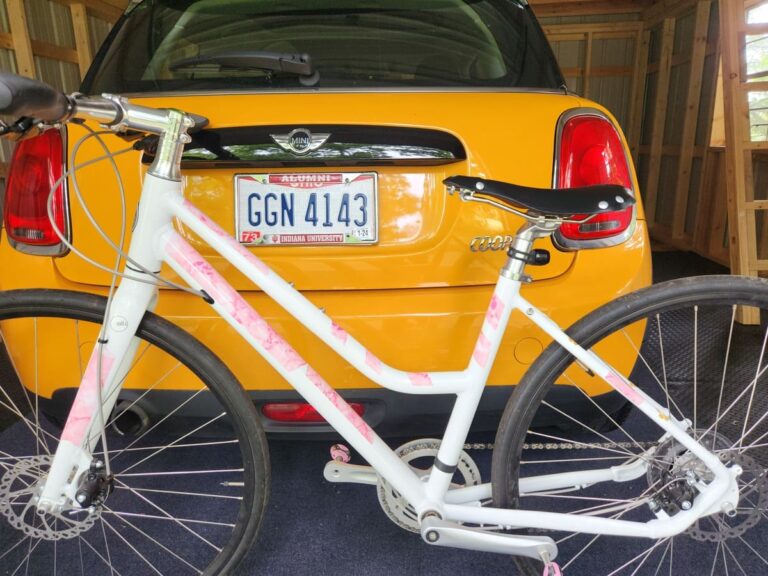
![Best Electric Trikes for Seniors: 7 Expert Picks for [Year]](https://www.foldingbikeguy.com/wp-content/uploads/Electric-Tricycle-for-Seniors.jpg)
![SLSY Folding Tricycle Review [Year]: My Honest Opinion](https://www.foldingbikeguy.com/wp-content/uploads/SLSY-Folding-Tricycle-Review.jpg)
